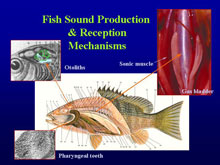
Fish morphology diagram illustrating the sound producing mechanism associated with the gas bladder and sonic muscles in the sand seatrout, Cynoscion arenarius. Click image for larger view and image credit.
Oceanic Biological Sounds: Mating Calls From The
Sea
R. Grant Gilmore, Jr., Ph.D.
Senior Scientist
Estuarine, Coastal and Ocean Science, Inc.
Aquatic Biological Sounds
Types of sound - Marine animals produce a wide variety of sounds using an equally wide variety of mechanisms to produce sound. Marine mammals are probably the best known sound producers: humpback whales for their underwater serenade, bottlenose dolphins for their squeals, squeaks and high frequency sonar. Snapping shrimp crackles, produced by snapping their claw rapidly through the water and producing a popping gas bubble, are familiar to most reef divers. However, few people realize that fish are major sound producers in the world ocean, particularly at night when humans have tied their boats back up at the dock.
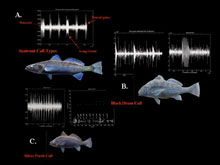
Spectrograms showing the variety of pulse types that are produced by various species of fish: (a) spotted seatrout, Cynoscion nebulosus; (b) black drum, Pogonias cromis; (c) silver perch, Bairdiella chrysoura. Click image for larger view and image credit.
Fish produce sound by stridulating teeth, bones and gas bladders with muscles, often modified as sonic muscles. In many fish that have been studied in detail, the frequency of sonic muscle vibration attached to the sound-producing organ actually produces the fundamental frequency of the sound. For instance in the drums and croakers, family Sciaenidae, the frequency of their loud mating calls is directly related to the vibratory frequency of the sonic muscle. The decibel level of a large male Atlantic toadfish calling his mate approximates that of a car horn while standing 5 meters in front of the car. Fish produce a variety of mating calls from drumming sounds, knocks, clicks, whimpers, booms, and grating sounds to rapid pulses in a series and staccatos. Most calls are below 5,000 Hz in frequency and often not over 1,000 Hz with fundamental frequencies from 10-700 Hz. Fish hearing is most acute between 100 and 10,000 Hz, but may extend up to 20,000 Hz, rarely showing sensitivity to ultra sound frequencies above 20,000 Hz (recently detected in menhaden and American shad). The human ear can hear frequencies from 20 to 20,000 Hz, with most intelligible speech falling within the range of 500 to 2500 Hz.
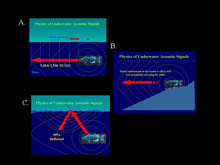
Physics of underwater sound: (a) Sound travels five times faster in water than in air; (b) sound attenuates less in water; (c) most underwater sound energy is reflected at the water's surface. Click image for larger view and image credit.
Physics of sound - Sound travels five times faster under water than in air and attenuates less. Therefore, sound communication is much more efficient in the sea than on land. Over 90% of the underwater sound is reflected at the air-water interface. Therefore, unless undersea sounds are extremely loud on a quiet night with little surface noise and turbulence, it is difficult for humans to hear undersea sounds. If the water is deep, robust undersea sounds may carry for miles. Whales can communicate over hundreds of miles using particular frequencies. There is a sound channel in the thermal (temperature) and photo (light) transition zone in the ocean around 600- to 1,500 ft in depth, depending on where you are in the world ocean. Loud sounds in the sound channel have been known to travel thousands of miles. Considering over 90% of the ocean is eternally dark, and half the time shallow coastal waters are in the dark at night, and turbid river and estuarine waters are nearly always opaque, it is no wonder that we are finding that hundreds of fish species produce diagnostic sounds, as the sense of vision in such conditions may be of limited use.
Undersea sounds are recorded on an undersea microphone called a hydrophone. Hydrophones for fish sounds are usually most sensitive to sounds from 10 to 20,000 Hz. These hydrophones are then wired to a recorder of some sort, from analog tape decks to digital tape recorders or computers. On the Florida Coast Deep Corals expedition, we will be using an undersea pressure vessel containing a small computer attached to an external hydrophone. This unit will be able to record continuously for several days and store the sounds until the unit is retrieved.
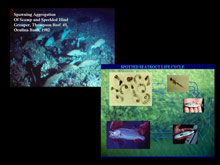
Aerial and underwater submarine photos of spawning aggregations of scamp, speckled hind grouper and spotted seatrout, all of which are sound-producing fishes. Life history of the spotted seatrout is depicted. Egg numbers are directly proportional to sound intensity. Click image for larger view and image credit.
Why Do Marine Organisms Produce Sound?
Most marine mammals are known to produce sounds socially to communicate with other members of their species. Much of this communication has to do with important life history activities such as courting and mating, feeding and capturing prey, escaping predators or caring for young. It is becoming clear that although fish may produce sound as warning displays and in feeding, most fish sound is produced to call mates for reproduction. The intensity of sounds produced by mating choruses of male estuarine spotted seatrout and silver perch has been found to be directly proportional to the number of eggs and larvae in the water column. Thus, even though spotted seatrout and silver perch females cannot produce mating calls, they are stimulated enough by male calling activity to mate more often or release more eggs when male call intensity increases. Female frogs and birds often choose mates based on the quality of the male mating call. Although this has not been sufficiently investigated in fish, it is likely that female spotted seatrout choose their mates based on the quality of male mating calls.
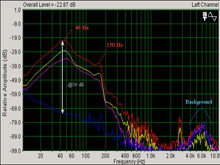
Spectra of three different calls of different goliath grouper reveal species specific call patterns based on energy distributed between specific frequencies. Click image for larger view and image credit.
Species Specific Diagnostic Sounds
We now know that not only does each fish species produce sounds that are distinct for that species, but that even individual fish (Atlantic toadfish) may be recognized by individual sound characters. The characteristics of the sound that are so diagnostic are the fundamental frequencies and harmonic patterns produced by each species' uniquely-formed sound producing mechanism. Therefore, the spectra of frequencies produced by the spotted seatrout are quite different from the spectra of the sand seatrout that is in the same genus, Cynoscion. The time elements, or separation between sound pulses, are also often diagnostic, though more variable. It appears that fish actually use variation in pulse patterns to send different messages. However, this has not been adequately studied to date. It is estimated that at least 200 fish species produce mating calls at night on the east Florida continental shelf. As one proceeds down the continental slope to depths deeper than 200 m to 1,000 m we find a host of species that can produce robust sounds, many classified in the large group called the Paracanthopterygii, which includes the cod, hake, ling, and rattails. All have sonic muscles and many have been studied as they produce mating calls. Thus to know that a hake is present and spawning does not require their capture, just a hydrophone and recording mechanism.
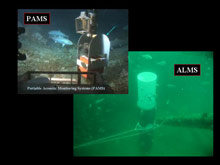
Remote acoustic recording systems (PAMS, ALMS) placed on the bottom to record fish sound production related to spawning and social interactions. Click image for larger view and image credit.
Sounds As A Tool In Studying Biological Activity In The Ocean
It is now possible to place hydrophones in the deep sea to record sound activity. First the sound producer has to be identified. There are several ways to do this, but the most effective is to see the fish while it is producing sound. We have done this with low light undersea cameras on robotic vehicles, or placed stationary on the bottom. It is also possible to classify the types of sounds that can be produced by families of fishes whose calls are known and whose sound producing mechanism is known. For example, the hundreds of species of sciaenids, drums and croakers found worldwide are going to drum and croak. The hundreds of species of jacks, family carangidae, are often using their pharyngeal teeth to produce sound. Once the sound is classified to species and you know that it is associated with spawning activity, then one of the most critical activities in the life history of the fish can be isolated for study. The location, time and environmental conditions under which the species spawns can be monitored without interfering in fish behavior by lowering nets, traps or baited hooks. This is very important in determining species presence and spawning potential for future generations of progeny and predicting fishery production years into the future.
























